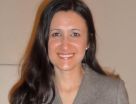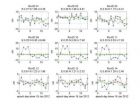(Press-News.org) Among older women, getting a mammogram every two years was just as beneficial as getting a mammogram annually, and led to significantly fewer false positive results, according to a study led by UC San Francisco.
The national study of more than 140,000 women between the ages of 66 and 89 appears online February 5, 2013, in the Journal of the National Cancer Institute.
"Screening every other year, as opposed to every year, does not increase the probability of late-stage breast cancer in older women," said lead author Dejana Braithwaite, PhD, a UCSF assistant professor of epidemiology and biostatistics. "Moreover, the presence of other illnesses such as diabetes or heart disease made no difference in the ratio of benefit to harm."
From 1999 to 2006, data were collected on 2,993 older women with breast cancer and 137,949 women without breast cancer – "the largest available screening mammography data set in the United States," according to Braithwaite.
The researchers found no difference in rates of late-stage breast cancer between women screened annually and women screened biennially.
However, they found that 48 percent of women between the ages of 66 and 74 who were screened every year had false positive results, while 29 percent of women in the same age range who were screened every two years had false positives.
"Women aged 66 to 74 years who choose to undergo screening mammography should be screened every two years," said senior author Karla Kerlikowske, MD, a professor of medicine at UCSF and a physician at the UCSF-affiliated San Francisco VA Medical Center. "They get no added benefit from annual screening, and face almost twice the false positives and biopsy recommendations, which may cause anxiety and inconvenience."
Braithwaite noted that the study "fills an important information gap, since accountable care organizations do not address screening intervals or screening cessation in women of advanced age or with a significant burden of illness."
She concluded that, taken together, "these results point to a need to consider life expectancy and co-existing illnesses in informing future recommendations about cancer screening in the elderly."
INFORMATION:
Co-authors of the study include Weiwei Zhu, MS, of the Group Health Research Institute, Seattle, WA; Rebecca A. Hubbard, PhD, of GHRI and the University of Washington; Ellen S. O'Meara, PhD, of GHRI; Diana L. Miglioretti, PhD, of GHRI and UW; Berta Geller, EdD, and Kim Dittus, MD, PhD, of the University of Vermont; Dan Moore, PhD, of UCSF; Karen J. Wernli, PhD, of GHRI; and Jeanne Mandelblatt, MD, MPH, of Georgetown University.
The study was supported by funds from the National Cancer Institute of the National Institutes of Health (CA150007, CA148577), the National Cancer Institute-funded Breast Cancer Surveillance Consortium (CA63740, CA86076, CA86082, CA63736, CA70013, CA69976, CA63731, CA70040, HHSN26120110031C), the American Cancer Society and the Agency for Healthcare Quality and Research.
UCSF is a leading university dedicated to promoting health worldwide through advanced biomedical research, graduate-level education in the life sciences and health professions, and excellence in patient care.
Follow UCSF
UCSF.edu | Facebook.com/ucsf | Twitter.com/ucsf | YouTube.com/ucsf
Mammogram every 2 years has same benefit as yearly mammogram for older women, UCSF study finds
Yearly test leads to more false positive results, say researchers
2013-02-05
ELSE PRESS RELEASES FROM THIS DATE:
Cargo container research to improve buildings' ability to withstand tsunamis
2013-02-05
Anyone who has seen the movie "Impossible" or watched footage from the Japanese tsunami has learned the terror that can strike with little warning. In those cases, when there is no time to flee, there may still be time to reach higher ground, called vertical evacuation.
But as you race to the third floor, how do you know if the building will hold up? Walls of water are not the only danger. Another potentially lethal challenge is water-driven debris - such as 60,000-pound fully loaded cargo containers - transformed into projectiles. Often pulled behind semi-trucks on highways, ...
Olive oil component alleviates intestinal ischemia and reperfusion
2013-02-05
Here's another reason why you should include olive oil in your diet: A new research report published in the Journal of Leukocyte Biology suggests that at least one compound in olive oil significantly reduces intestinal ischemia (restricted blood supply) and the resulting reperfusion injury (tissue damage caused when blood supply returns). The compound, called "oleuropein aglycone," is the most prominent polyphenol found in olive oil and could become a novel therapeutic target aimed at treating intestinal ischemia and reperfusion injury in humans. Ultimately, this research ...
Flexible classroom design saves money, improves flexibility, accessibility of instruction
2013-02-05
Researchers at North Carolina State University have developed a classroom design that gives instructors increased flexibility in how to teach their courses and improves accessibility for students, while slashing administrative costs.
Specifically, the new classrooms take advantage of the fact that students are bringing their own technology – such as laptops – to class. The classrooms also include mobile infrastructure, where whiteboards, desks and tables can be reconfigured according to the needs of students and instructors.
"These classrooms work really well in terms ...
Chest pain prior to a heart attack can protect the heart
2013-02-05
MINNEAPOLIS, MN – Feb. 5, 2013 – Patients who experience chest pain in the 24 hours preceding a heart attack, also called preinfarction angina, have smaller heart attacks and improved cardiac function in the contemporary cardiac stenting era, researchers found in a study published Jan. 22 in Circulation: Cardiovascular Interventions.
"Even before we began treating heart attack patients with angioplasty and stenting, physicians recognized that patients with chest pain prior to their heart attack seem to have better outcomes," says the study's senior author, Jay H. Traverse, ...
Precise Point Positioning and real-time positioning accuracy for COMPASS satellite navigation
2013-02-05
COMPASS uses the Geostationary Earth Orbit (GEO) and Inclined Geosynchronous Satellite Orbit (IGSO) satellites, which are more suitable for regional services. Its constellation is composed of 14 satellites, including 5 GEO, 5 IGSO satellites and 4 Medium Earth Orbit (MEO) satellites. As of 2012, 13 satellites have been launched. Except for G2 (unusable) and M1 (testing only), the remaining 11 satellites, including 4GEO+5IGSO+2MEO, have successfully transmitted signals and broadcasted navigational messages, to prepare for full operation starting in 2013.
Positioning accuracy ...
The zebrafish revealed a central regulator for the development of the brain histamine system
2013-02-05
Research has shown that mutations in the psen1 gene are common in the familial forms of Alzheimer's disease, and the Presenilin-1 protein that the gene encodes is known to be involved in the cleavage of the amyloid precursor protein. In Alzheimer's disease the amyloid precursor protein is not cleaved the normal way, and the protein accumulates in the brain damaging neuronal tracts and neurons. It is still unknown if the psen1 gene is involved in the etiology of Alzheimer's disease via another mechanism.
Professor Pertti Panula's research team at the University of Helsinki ...
Growth arrest in prostate cancer
2013-02-05
A previously poorly investigated signalling pathway is crucial for the growth and proliferation of prostate cancer cells. An international research team discovered this when studying the enzyme "soluble adenylyl cyclase" that produces the second messenger molecule cAMP. When the scientists inhibited the enzyme, the cancer cell proliferation was suppressed. The team led by Dr. Yury Ladilov from the Department of Clinical Pharmacology at the Ruhr-Universität Bochum reported together with colleagues from the Department of Urology at the RUB and the Cornell University in New ...
A review of the rapidly evolving field of topological insulator hybrid structures
2013-02-05
Topological insulators are novel materials that are insulating in the bulk but have surface states that are conducting. These surface states are topologically protected and possess several intriguing properties with the promise of potential applications. As a result, topological insulators have attracted many theoretical and experimental studies in the last few years. More recently, the potential of interfacing topological insulators with other materials with quantum states to make hybrid structures has been recognized and a slew of new studies are underway. Professor Jian ...
1 out of 4 lung cancer patients in Andalusia does not receive the radiotherapy they need
2013-02-05
A study conducted by University of Granada and Virgen de las Nieves U.H. researchers has revealed that in Andalusian public hospitals radiotherapy is provided to lung cancer patients with a frequency 25 % below that established by clinical protocols. Failure to provide such treatment results in a total of 3,000 survival-day loss for all lung cancer patients.
To carry out this study –recently published in the Journal of Thoracic Oncology–, the researchers reviewed the medical records and radiotherapy provided to all lung cancer patients in 2007 in the 12 Andalusian public ...
Seeing the software world from a dependency perspective
2013-02-05
Software development is a complex and difficult task. Software developers and researchers try to deal with software development in a simple way from multiple perspectives. This leads to the use of various kinds of models, including informal, semi-formal, and formal models, and all kinds of development methods, including informal and formal methods. In fact, every software development method contains multiple models from different perspectives. In contrast to an informal method, a formal method is considered to be a set of tools and notations (with formal semantics) used ...
LAST 30 PRESS RELEASES:
Weaving secondary battery electrodes with fibers and tying them like ropes for both durability and performance
Using social media may impair children’s attention
Science briefing: An update on GLP-1 drugs for obesity
Lower doses of immunotherapy for skin cancer give better results
Why didn’t the senior citizen cross the road? Slower crossings may help people with reduced mobility
ASH 2025: Study suggests that a virtual program focusing on diet and exercise can help reduce side effects of lymphoma treatment
A sound defense: Noisy pupae puff away potential predators
Azacitidine–venetoclax combination outperforms standard care in acute myeloid leukemia patients eligible for intensive chemotherapy
Adding epcoritamab to standard second-line therapy improves follicular lymphoma outcomes
New findings support a chemo-free approach for treating Ph+ ALL
Non-covalent btki pirtobrutinib shows promise as frontline therapy for CLL/SLL
University of Cincinnati experts present research at annual hematology event
ASH 2025: Antibody therapy eradicates traces of multiple myeloma in preliminary trial
ASH 2025: AI uncovers how DNA architecture failures trigger blood cancer
ASH 2025: New study shows that patients can safely receive stem cell transplants from mismatched, unrelated donors
Protective regimen allows successful stem cell transplant even without close genetic match between donor and recipient
Continuous and fixed-duration treatments result in similar outcomes for CLL
Measurable residual disease shows strong potential as an early indicator of survival in patients with acute myeloid leukemia
Chemotherapy and radiation are comparable as pre-transplant conditioning for patients with b-acute lymphoblastic leukemia who have no measurable residual disease
Roughly one-third of families with children being treated for leukemia struggle to pay living expenses
Quality improvement project results in increased screening and treatment for iron deficiency in pregnancy
IV iron improves survival, increases hemoglobin in hospitalized patients with iron-deficiency anemia and an acute infection
Black patients with acute myeloid leukemia are younger at diagnosis and experience poorer survival outcomes than White patients
Emergency departments fall short on delivering timely treatment for sickle cell pain
Study shows no clear evidence of harm from hydroxyurea use during pregnancy
Long-term outlook is positive for most after hematopoietic cell transplant for sickle cell disease
Study offers real-world data on commercial implementation of gene therapies for sickle cell disease and beta thalassemia
Early results suggest exa-cel gene therapy works well in children
NTIDE: Disability employment holds steady after data hiatus
Social lives of viruses affect antiviral resistance
[Press-News.org] Mammogram every 2 years has same benefit as yearly mammogram for older women, UCSF study findsYearly test leads to more false positive results, say researchers

